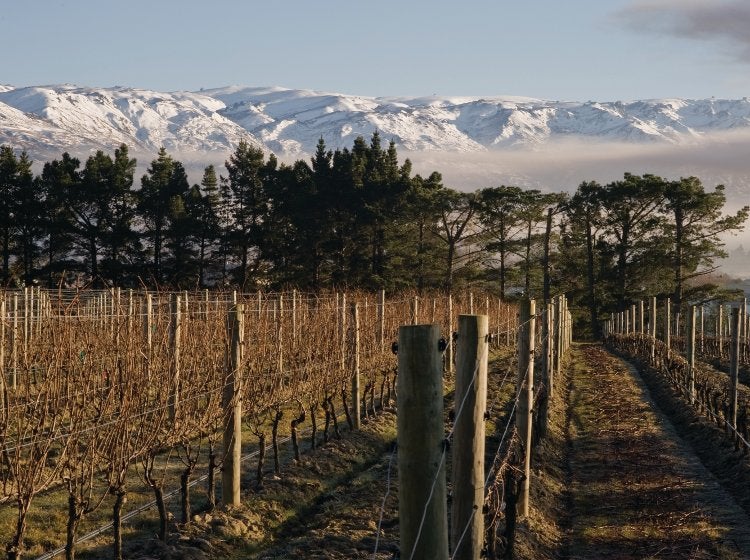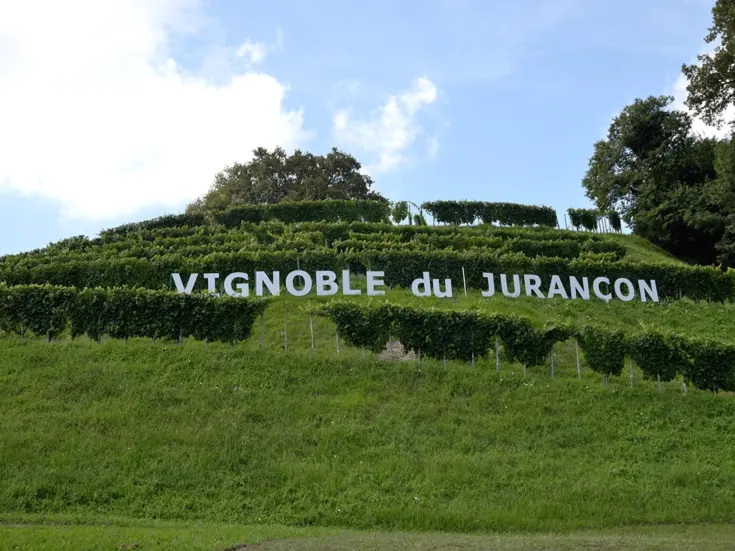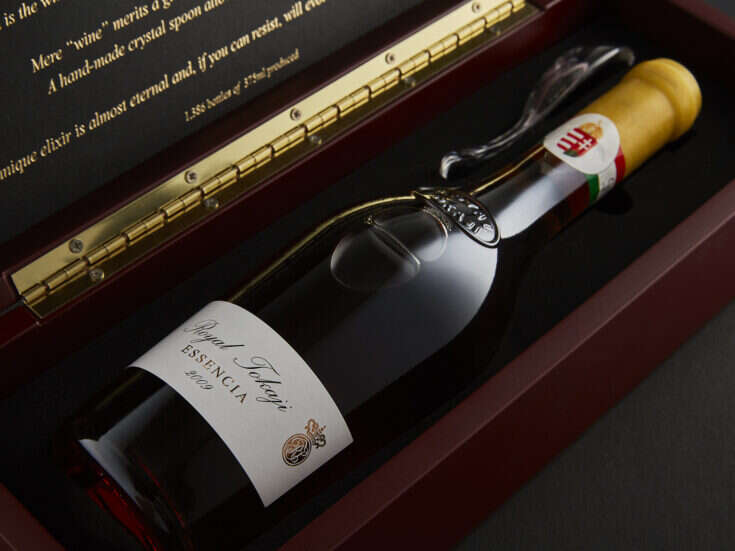
It’s disconcerting to be interviewing someone who looks quite so much like British entrepreneur Richard Branson. Fellow Brit Nigel Greening has the same engagingly shaggy blonde hair, the beard, the air of hippydom-made-good. Were they separated at birth? If you know about one, can you know about the other? Is that something to do with Heisenberg’s uncertainty principle?
I only suggest this last because, when we meet, Greening is sporting a T-shirt printed with Heisenberg’s uncertainty principle. It is no accident that Greening is fanatical about Pinot Noir, a grape that encourages uncertainty more than any other. Felton Road Block 5 is one of New Zealand’s top Pinots and one of the wines that has established Central Otago as the country’s most exciting Pinot region; he also has Pinot from Block 3, Cornish Point, Calvert, and Bannockburn. There is Chardonnay, too, and Riesling. All have a purity of style that owes a lot to Burgundy, even more to science, and very little to technology. Greening is, by inclination, a scientist, though one who focuses on what we don’t know as much as on what we do.
Greening is almost entirely self-taught, and self-taught in every aspect of his multifaceted career. Dropping out of a biochemistry course to seek a career as a guitarist was his farewell to formal education, but it hasn’t stopped him studying science informally. Math, too. Ask him if there’s anything he regrets not having studied in any formal way, and he’ll say, math (and he’s not talking about arithmetic). “My math is better than it was; it was never bad, but I’ve taught myself more over the years. I would love to have had a wonderful grounding at school. Math is at the core of everything; it describes the universe. But to change one thing in your life would be to change where you are now.”
When playing the guitar proved not to be the way forward, Greening set up a design company, then moved to a bigger one, then set up his own company again. By now he was doing special effects for big product launches for BMW and Porsche, Olympic ceremonies and similarly high-end stuff. He was a bit of a petrolhead in his way. But in time he decided to get out, sell his equity, and have an outside project. By now it was 1997, and there were two offers on the table. One involved running the UK millennium celebrations, in which he was already involved; the other was with BMW, sorting out a problem in the Far East and the Pacific Rim.
He opted for BMW, but he hated the idea of living anywhere hot, so he said he’d take the job if he could live in New Zealand. When I mention that Greening was already a serious Burgundy lover, you will see how neatly the elements of the equation begin to fall into place.
Epiphany
He’d never taken New Zealand wine particularly seriously, but now he started finding a few he liked; however, he still had no ambition to get into wine. “My epiphany came 12 months after I arrived,” he said. “I was driving along, and I heard an item on the radio news that a tiny winery in Alexandra called Dry Gully had just won a show trophy with its first-ever wine. I happened to be driving to Alexandra, so on a whim I decided to find out more. I found out where the owners lived — they were a retired couple who’d planted 3ha [7.5 acres] of vines in their back garden and passed them over to the local contract winemaker, Mike Walters, but he’d died halfway through vintage. So Rudi Bauer [of Quartz Reef] had stepped in. It was Rudi who’d sent the wine into the show, and the owner woke up and found he’d won a trophy.
“It was, by some margin, the best New World Pinot Noir I’d tasted. I was familiar with Calera and the early California Pinots, and with Oregon, but this turned my head. It had been grown by someone who knew nothing about it, and I thought, I could do that.”
So, he started looking more closely: at the land, at the terroir, at textbooks. “I read everything I could get my hands on: the nature of what makes a great site, geology, climate,” the lot. Because Burgundy was his first love, “one thing was absolutely clear: You can’t move the vineyard. Site is everything.” During this time, the first release from Felton Road appeared, and that was equally impressive; and after six months, he had a list of three sites that were buyable, of which Cornish Point was one. “I decided I needed advice, and I knocked on Rudi Bauer’s door. He was a bit hungover — he’d been named Winemaker of the Year the night before — but he was very helpful.” Bauer reckoned that, given the research that Greening had already done, there was no reason why it shouldn’t work.
Alan Brady, the first man to plant Pinot Noir in Central Otago (which locals refer to as Central, which is quite funny for somewhere in the back of beyond) was the next to have his door knocked on: He knew all about starting a vineyard from scratch. They drew up a plan to work together and bought Cornish Point for a then record price of NZ$30,000 per hectare for 7-8ha (17-19.5 acres) of vines. “That would be fantastically cheap now,” says Greening. It had water, and it had an apricot orchard.
Felton Road became the benchmark for Greening’s new project. “We followed the wines really carefully; we were always putting our noses over the fence. Up until then, people had planted where they had land; Stewart [Elms, founder of Felton Road] was the first to look for terroir. When he designed the vineyard it was meticulous. He’d planned every detail. Stewart wouldn’t talk too much; he was not a chatterer. He kept things close to his chest. But when I finally bought Felton Road and compared it to Cornish Point, I found we’d nearly always reached the same conclusions, except that his planting densities were way too low. We’d spotted early on that higher densities were needed in Central.” Thinking had moved on by then; tractors were narrower, too.
By 2000, Greening was living not in New Zealand but in Surrey, England. One day, the telephone rang with the news that Stewart was selling Felton Road. He rang Alan Brady, who had only just heard. “I said, ‘Go round, knock on the door, and see what he says.’ He’d had an offer, so I said, ‘Tell him I’m getting on a plane in the morning and that he’s not to sign until I get there.’
“Over about two hours, we did a deal. I gave him everything I owned except the house, and he gave me Felton Road. I didn’t think about it. I’d spent all my life making bad financial deals, but I’d made enough not to have to work again, and I was chancing the lot, but not for one second did I doubt. I’m not a rash person, but I just knew that it only goes past your door once. I’d seen people do this in the past, make enough money and then risk it, and I’d thought, How stupid. Most of the people who go bust once had more money than they needed. I had a one-line consultation with my wife: I said, I may be going out and spending rather a lot. She said, ‘You made it; you spend it.'”
A changing relationship with the land
Felton Road had by this time made three vintages. “It had made a bit of noise and was starting to come to a few people’s attention, but it was starting to get a bit flaky,” says Greening. “Stewart and Blair [Walter, the winemaker] were not seeing eye to eye. The 1999 vintage was cropped very heavily, and there was little chance Blair would have been there much longer.
“I knew Blair a bit, and we sat under a tree and had a beer and wrote out a plan.” This involved back-of-an-envelope calculations of the least they could make while not starving but not buying helicopters, and the upper point at which it would stop being a craft and start being a big brand. “And they weren’t far apart.” The problem was that Felton Road wasn’t really financially viable on its own: “There wasn’t enough to go around.” Above 12,000 cases, they reckoned they wouldn’t be able to know every barrel. And below 10,000 cases wasn’t really viable. But there was Cornish Point to add to the equation, there was a bit more land to plant at Elms — Stewart Elms’s original vineyard — and they took the lease of Calvert Vineyard across the road. (They’re planting another vineyard, next to Calvert and with similar characteristics, as a long-term replacement for Calvert in the expectation that it will in time revert to its owner.)
At the same time, Greening decided to go organic. Biodynamism came later, and by April 2006 they were certified biodynamic. “We hadn’t wanted to be certified, but we were seeing more and more spurious claims, and we thought that there’d be a backlash, and one day we’d need certification or we’d look stupid.”
It’s always an interesting conjunction, science and biodynamism. But this is where Heisenberg comes in: “You can’t know everything,” says Greening. Nevertheless, “you have to separate biodynamism from science. That’s heresy to those that regard biodynamism as a religion, something sacred. I’m not one of them. Ideas are not responsible for the people who created them. Steiner had some brilliant ideas. He was the first person to tread into the area of regarding land as an entire ecosystem, though today we all nod wisely and say, ‘Of course.’ He was a man of brilliant ideas, but he was also pretty loopy. It’s a process of filtration, of finding what really matters and what I can leave behind.”
What biodynamism means in essence, he says, is “learning that your relationship with the land is negotiation, not dictatorship. I don’t care about calendars, though they’re on our website. It’s the same with biodynamic preparations; maybe they’re important, maybe not. It’s all about your relationship with the land, and the way you approach that relationship. You can’t negotiate with something you don’t understand.” Making their own preparations, which they’re now getting into, he compares to “mumbling hymns in church”: something that does no harm. Preparation 500 (that’s the cow’s horn filled with dung and buried over the winter) has “so high a microbial content, it’s bug soup.” Others are good compost accelerators. His real faith is in his team. “Every year, we have 40 to 50 applications from newly qualified viticulturists who want to come here. We have the best-qualified, most motivated viticultural team on the planet. It tops a stag’s bladder any day for benefits from biodynamism.”
The biggest lesson
But this is not to claim that he, or they, claim to know what they are doing. “Because you get so few goes at it, any winemaker who stands up to pontificate about his craft is bullshitting,” he says; it’s back to Heisenberg and the limits of what we can know. “The biggest lesson was deciding we didn’t want to make better wine because we didn’t know what ‘better’ meant anymore. There came a point when we really didn’t know what that meant. You look back at vintages, but it’s only your opinion, and you’re not fit to judge.” He accepts that it takes considerable restraint not to play that game. “The wine will be what it will be, and we won’t try to intervene to make it better. It’s hubris, believing you know better, when you don’t… As long as you tinker with things, you will never know what would have happened if you hadn’t.”
So, they don’t tinker. “We’ve always been low intervention, but it’s kind of silly now. Something has to be an extreme case before we go near it.” He quotes, as an example, some Chardonnay that wouldn’t ferment dry. “The only thing the winemaker changed was the music. It went dry in the end. It teaches you to get your hands off.”
Yeasts are indigenous, and malolactics are wild. The winery is gravity-flow, no inert gas is used, and they never chaptalize, but sometimes they acidify the Pinot to replace the tartaric that occasionally crystallizes out during fermentation; the aim is to finish with the same tartaric level they measured in the vineyard at harvest. The Pinots are unfined and unfiltered. Chardonnay is normally unfined and either gets no filtration or just a light polish. Rieslings are sterile filtered because they have residual sugar. No animal products are used in the winery except for lunch — of which more later. They use a bit of SO2, but even so, is this not natural winemaking? Are these not natural wines?
“Like pretty much everybody, I don’t understand the term ‘natural wine,'” he says. “It seems to be hijacking a word already in common usage to suit the agenda of a small number of producers, who regard whatever they do as ‘natural’ and whatever they don’t do as ‘artificial.'” He doesn’t object to being part of natural-wine events: “We make wine in a very natural way. But when you get into the zero-sulfur brigade, it gets a bit scary. I can completely understand how in some areas, if you have low natural pH, it’s possible to have very low sulfur and still have wine that will age, but it’s not a general rule, and I don’t understand why it’s particularly desirable. There’s no such thing as a natural wine; wine is an artificial construct. Most natural wine has SO2 as a product of fermentation and from the residue off the vineyard. [The natural-wine movement is] a group of people who are clutching at something, and even they aren’t sure what they’re clutching at.”
Instead, Greening quotes Goethe and his “idea that when you do something and it’s the right thing to do, other right things happen.” Going organic and then biodynamic produces “a cascade of good consequences; things happen that we never really understood before. Everything piles up, and we see extra benefits we never knew.” A simple one might be planting peas as cover crops and being able to pick mange-touts for lunch. Cover crops mean that the vine roots must go deeper, because in the top 20cm (8in) of soil the cover crops rule the roost, and then they don’t suffer from drought stress; a lot is now dry-farmed from fruit-set.
Food and music
Where Greening is thoroughly hands-on, however, is in the kitchen. “I’ve cooked every day of my life since I was 17”; he cooks at home, and he cooks at the winery. Lunch according to Greening might be venison or wild pig shot in the hills, a goat from the farm, or beef from the estate’s Highland cattle. Vegetables grow between the vines; there are nut trees and fruit trees. Does it sound idyllic? Greening’s cookbook, Felton Road Vintage Food, certainly makes you want to get out there and start picking grapes for the sake of the fish paella you might be served (the fish gets flown in; they haven’t yet worked out a way of rearing shrimps as a by-product of biodynamism) or Corn Three Ways, one of which is corn-fed chicken. Greening has now added television chef to his list of careers; he’s done a series about the wine harvest, its history, how it’s carried out today, its philosophy, and other Saccharomyces products like beer and bread. He cooks in it, naturally. And just as naturally, his cooking is self-taught.
And yes, he still plays the guitar every day. “My father was a jazz pianist, so I picked up a lot from him. I played blues guitar when I was young, but these days it’s 90 percent jazz. His heroes are Count Basie, Duke Ellington, Oscar Peterson, Wynton Marsalis… “Jazz is such a huge subject; it’s probably the most technical expression of music there is. Its harmonic complexity is greater than classical music. Its chord sequences, its scales, are so much more exciting; its combination of intricate tempi scales make it intellectually a lot more challenging.” And perhaps more uncertain?







